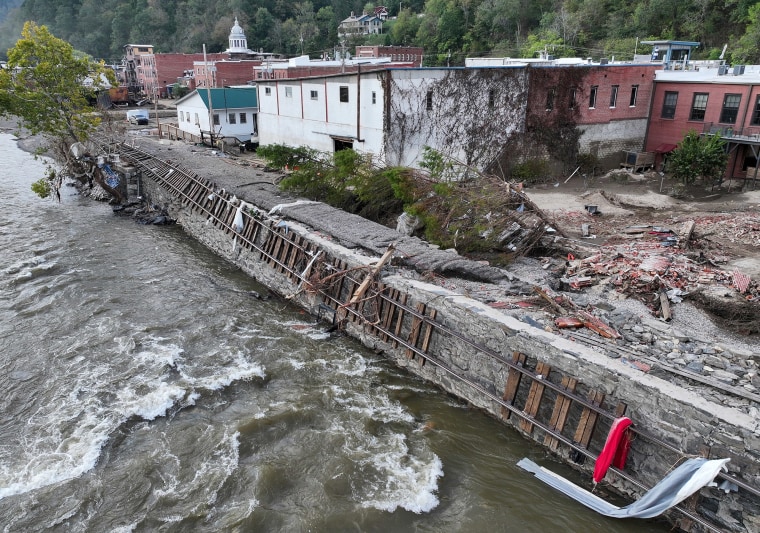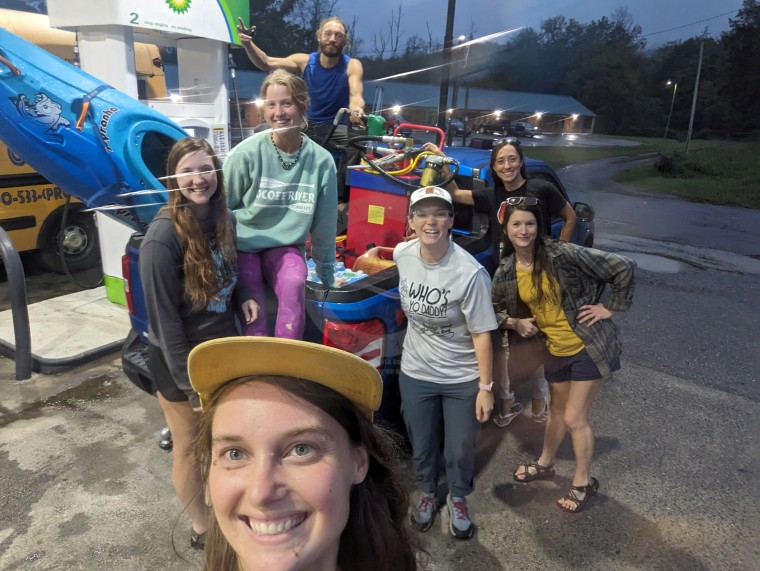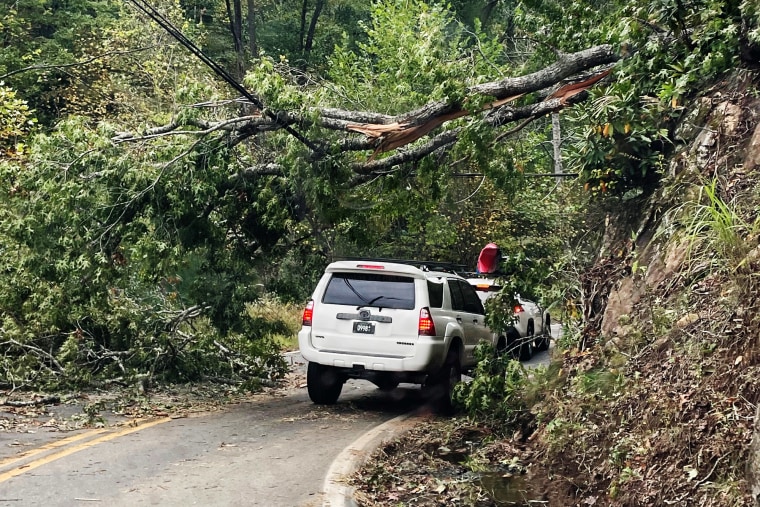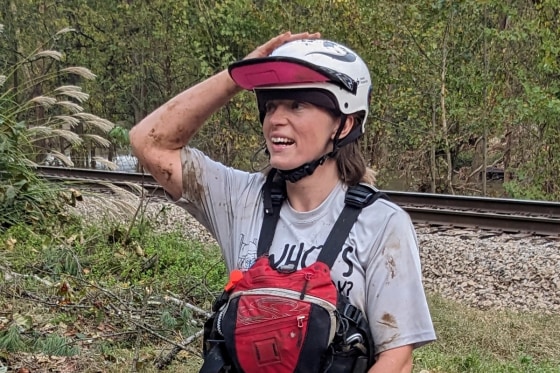Sarah Beth Neal expected to spend October organizing whitewater rafting trips for visitors on the Ocoee River in eastern Tennessee. Instead, the owner of Outdoor Adventure Rafting has been deploying search-and-rescue crews in the wreckage of Hurricane Helene.
By Friday, a small scouting crew of raft guides that she sent to Florida was on the ground clearing trees after Hurricane Milton dealt a second deadly blow this week.
“We have an abundance of skills and talents here that are phenomenally helpful during natural disasters,” Neal said. “We use them to go play around in whitewater, but in the case of an emergency, we really want to be able to help.”

Other whitewater rafting operators across the region have also pivoted from recreation to emergency response.
“We’ve been using our own rafts and our guides to search the river [and] to help other organizations get to where they need to go,” said Mitch Hampton, who co-owns French Broad Adventures with his wife and brother in Marshall, North Carolina, 40 minutes north of Asheville.
The company typically sends around 900 people rafting on the French Broad River each October but has seen bookings evaporate. Hampton has refunded $85,000 in trip reservations during what’s usually the busy final month of the rafting season — when the region is decked out in autumn foliage that ordinarily draws legions of visitors. Hampton expects to feel the pain for a while, as the company relies on fall revenue to open its spring season.
We have an abundance of skills and talents here that are phenomenally helpful during natural disasters.
Sarah Beth Neal, owner of Outdoor Adventure Rafting
In the meantime, 20 to 30 of Hampton’s staffers have been volunteering to shuttle people and provisions — first through floodwaters and then over debris-strewn ground — and check on residents, some of whom have gone weeks without reliable access to food, power or running water.
Over 100 people have died in North Carolina from Helene, a storm turbocharged by climate change. Hundreds more remain missing, most from inland flooding — the second leading cause of hurricane deaths after storm surges, according to the National Weather Service.

Hampton, an experienced river guide and volunteer firefighter, said he’d never done rescues in floodwaters this dangerous before.
The French Broad normally runs at about 2,000 cubic feet per second this time of year, he estimated. That’s already fast, but in the storm’s immediate aftermath, its discharge was literally off the chart maintained by the U.S. Geological Survey, exceeding 40,000 cubic feet per second. Hampton and others speculate the true peak level might have been twice that. (A USGS spokesperson didn’t respond to a request for comment.)
Water rescue has always been crucial during big storms, and many emergency protocols were developed by recreational whitewater guides, said Tim Rogers, a longtime firefighter and rescuer who lives in Charlotte and trains teams for flood response.
They do this every day. They know how to read the water.
Tim Rogers, emergency RESPONSE trainer, Charlotte, N.C.
“They do this every day,” Rogers said. “They know how to read the water.”
Neal, who lives in Sweetwater, Tennessee, posted on Facebook on Sept. 29 offering housing and supplies to those in need. By the next day, she’d recruited nearly 70 swift-water-trained wilderness responders and had partnered with a local fire department to assist in the field.
“I was getting a call or a text every 20 minutes or so from somebody who wanted to volunteer or somebody who needed help of some variety,” Neal said.
The group, calling itself Riverfolk Rescue, has since grown to nearly 200 volunteers who are reaching isolated communities, dropping off supplies and shoveling mud across western North Carolina. Neal said no one involved expected to be using their mountaineering and rafting skills after a hurricane, but they’re capable of handling rescues in difficult terrain.

“There are a lot of challenges to the Appalachian Mountains that outsiders are not going to be equipped for or expect,” Neal said, adding that there’s also “a large culture of distrust of authority” that local responders may have more success navigating.
The group’s team in Florida is still assessing the situation there, but local responders so far appeared to have things handled, Neal said. “It’s looking like we should keep most of our people and resources focused on NC and East TN,” she said in a text message Friday.
There’s still plenty to do in the region, where many residents are spread out and infrastructure in remote areas is less robust. Vast quantities of reddish-brown mud are an added obstacle, said Alexander Smith, a Riverfolk Rescue volunteer. “A lot of the silt has come up from the river, and it makes mud banks that are — I don’t really know how deep, but it sinks me to at least my thighs,” he said.
Hampton said it’s hard to imagine how long cleanup will take. More than two weeks since the storm hit, “we’re completely shut down,” he said. Near one of his “put-ins,” or rafting launch points, the current was so strong that it wrapped a metal cargo container around a bridge pylon.

Three of the five most popular rafting rivers in the U.S. — the Ocoee, the Pigeon and the Nantahala — are in western North Carolina or eastern Tennessee. Each has consistently received over 100,000 visitors a year, including during the pandemic, when tourists sought socially distant outdoor activities.
“We exist off of tourism and visitation and adventure,” said Kristin Kastelic, the marketing director at the Nantahala Outdoor Center, which operates rafting excursions and a retail store in Bryson City, North Carolina. Business owners in and around the city, which is tucked into the Great Smoky Mountains west of Asheville and saw comparatively less devastation, told NBC News last week that the collapse in visitor spending makes rebuilding even harder.
Kastelic said the center’s main location, which had little structural damage, has been providing Wi-Fi and meals. It was given the go-ahead to reopen rafting activities on the Nantahala on Friday and still plans to host its annual festival at the end of October to support the local community.
Still, Kastelic expects the area to lose hundreds of thousands of visitors, who come for a range of outdoor and other attractions. She declined to estimate her company’s revenue hit but said it would be significant.
“It’s almost overwhelming to see the amount that the small businesses have done to help aid people immediately, and they get no financial benefit from it,” Kastelic said.
Neal recalled seeing literal signs of financial unease during rescue missions: Some residents who’d been without essentials for days and headed elsewhere had tacked notes to their doors asking anyone with phone service to please call their bosses.
“A lot of the people we made first contact with, a lot of their concerns were, ‘I can’t pay my bills because I can’t go to work,’” she said, “which was pretty heartbreaking.”
